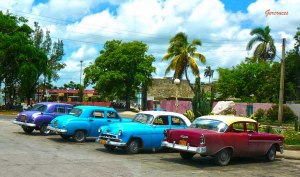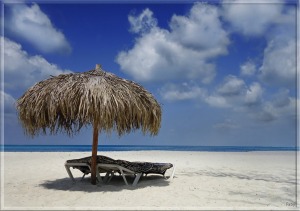It’s been more than 50 years since Fidel Castro came down from the mountains to lead a guerrilla movement ousting the corrupt, Mafia-tied Bautista regime in Cuba. Since that time, U.S.-Cuba relations have been both red hot (during the 1962 Cuban missile crisis) and icy cold (for most of the rest of the time since).
It’s time for a thaw, and I applaud President Obama’s initiative to restore full diplomatic relations with that island nation just 90 miles south of Key West.
As readers of this blog know, I always come down on the side of fewer travel restrictions between nations, not more. I think they lead to greater understanding among peoples, who often are far ahead of their governments in their innate grasp of the need to travel freely and exchange ideas and get to know each other’s customs and lives.
The President’s actions stop short of ending travel restrictions on Americans to Cuba — which will still not be open (yet) to mass tourism. But those who qualify — for “non-tourist” purposes such as family visits, people-to-people exchanges, conferences and other professional reasons, humanitarian projects, athletic competitions, journalists, and various others — will be able to travel more freely to Cuba.
For the most part, the average American “tourist” will still need to join a group “educational” tour, which has been the primary way U.S. citizens have had to travel to Cuba in recent years. But apparently Americans who qualify will be allowed to purchase plane tickets directly to Cuba and not have to receive official permission to visit there. These are all regulations that will have to be worked out.
I visited Cuba back in 1987 on assignment for Mother Jones Magazine, to do a piece on the Havana Film Festival, Latin America’s largest. It turns out that Fidel is almost as big a movie buff as baseball fan, and the Cubans had invited a number of the Hollywood elite to attend that year, along with 1,300 other foreign visitors, mostly from Central and South America .
While Robert Redford, Francis Ford Coppola and Faye Dunaway didn’t show, Oliver Stone was there, while he was still being lionized for his breakthrough film, “Platoon,” as were other prominent directors of the time, Arthur Penn (“Bonnie and Clyde”) and Bob Rafelson (“Easy Rider”). Actor Raul Julia was on hand, as was the globe-trotting journalist Christopher Hitchens.
We all piled into a mini-bus for various tours and events: a trip to Hemingway’s old finca, a night at the Tropicana nightclub — a pre-revolutionary cultural relic where the chorus girls wore feathers and the singers sported sequins — a meeting with the author Gabriel Garcia Marquez, who was a close friend of Castro. Then there was the bizarre trip to a Cuban women’s prison, where inmates put on a show “straight out of Fellini,” as someone put it, smiling, doing each other’s hair, even dancing and singing on cue.
It was the first time most of us had been to Cuba, and our reactions were decidedly mixed. Arthur Penn described it as a paradox, and most of us had to agree.
The prison show fooled no one; Cuban prisons were (and probably still are) notorious hellholes. Yet Penn’s wife, a psychologist, had just toured Cuban mental hospitals and came away impressed by their enlightened treatment methods. Free health care and free education were hallmarks of Castro’s regime.
But so were the long lines formed at stores to buy staple foods such as beans and rice, while wealthier Cubans were able to afford to dine at some of Ernest Hemingway’s old haunts or at a quaintly (and politically correct) named “North Vietnamese” restaurant.
Like the North Vietnamese reference more than a decade after the Vietnam War ended, much of Cuba seemed terribly dated. The 1950s-era Chevys and other “classic” American cars frequenting the roads were legends even then, almost 30 years ago — and they’re still famously running today, cobbled together with parts obtained by circuitous routes from other countries due to the U.S. economic embargo.
As guests of the Cuban government, we were treated royally, housed in Havana’s seaside National Hotel — which was off limits to ordinary Cubans, except, it seemed, for the beautiful young women invited to mingle at the lavish receptions held at the Film Festival sites. Other Cubans stood near the heavily guarded entranceway to the hotel, gawking as the privileged passed through.
We were allowed to wander freely around Havana without our otherwise ubiquitous guide who accompanied our tours (something even present-day American tour-group visitors are not allowed to do, or so I’m told). We were able to meet with any of the locals we wished, and Rafelson led a contingent of us in search of some “real” Cubans, which we found and spent a pleasant afternoon chatting with in their tiny apartment.
And to top off the week, we were invited to a food-and-drink-laden reception with Fidel, where we joined a maelstrom of guests all trying to reach El Jefe himself, to exchange a few words or just shake the hand of this paradoxical leader who inspired such strong emotions both north and south of Cuba.
One takeaway for me from the week in Havana was that the U.S. was making no friends in the rest of the Hemisphere by our embargo of Cuba. To put it bluntly, we were regarded as bullies. The embargo has hurt ordinary Cubans far more than the Castro regime, which, last time I checked, is still in power.
A good sign: Reactions to the Obama-Raul Castro announcement of restoring relations has been very positive from various South American leaders, some of whom are not friendly with the U.S. This action should go a long way in improving our relations with our neighboring countries to the south — and with the rest of the world as well, most of whom (including Canadians) have been able to travel freely to Cuba for years.
The fact is, El Jefe is out of the picture and has been for a number of years. His successor, brother Raul, may be a dictator but he has slowly moved to improve economic and travel opportunities for Cubans, who can now leave their country by means other than rafts and boats. Raul is someone we can deal with, just as Nixon going to China helped transform that country from one of the most closed societies in the world to one of the most entrepreneurial and mobile. Chinese tourists, so long unable to travel, are now taking over the world.
I hope the prominent Cuban-Americans in Congress — led by Senators Marco Rubio of Florida and Bob Menendez of New Jersey — aren’t able to thwart this forward-looking initiative by two countries that eventually can become friends again.
Yes, they have issues with the Castros. I get that. But it’s time. In fact, it’s way past time. The old policy hasn’t worked and 50 years of trying to isolate Cuba is way too long.
And easing travel restrictions is among the most important — and potentially the most important — element of normalizing relations.
Note to my readers:
It’s been a while since my last blog post,and here’s the reason: I’ve been working full time prepping a major new travel website where I’m Content Director. The site should be of great interest to baby boomers (and others). I’ll be able to give you more detail soon, so stay tuned. Meanwhile, I’ll be blogging much more often again.
And Happy Holidays to all!














2 Responses to U.S.-Cuba Thaw: It’s About Time